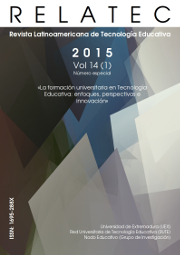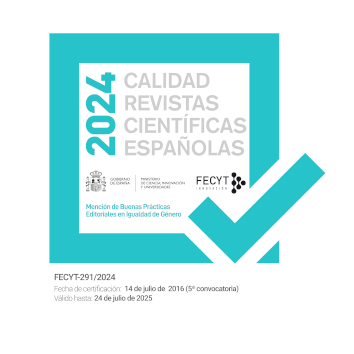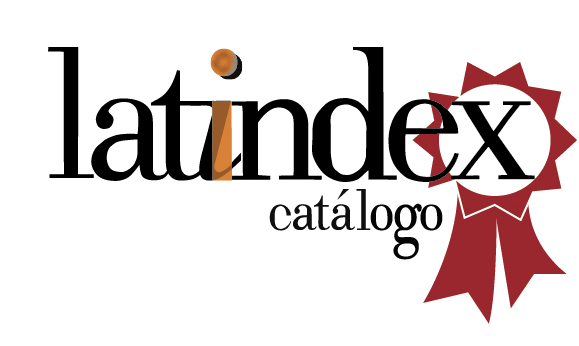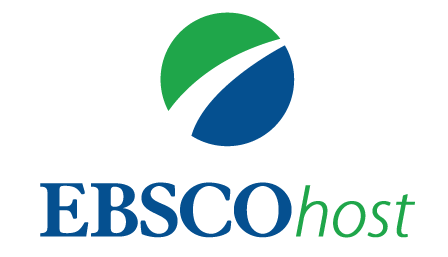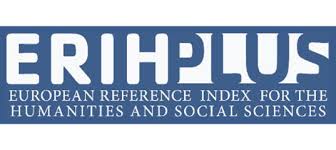Tecnologías y Diseño Universal para el Aprendizaje (DUA): experiencias en el contexto universitario e implicaciones en la formación del profesorado / Technology and Universal Design for Learning (UDL): experiences in the university context
DOI:
https://doi.org/10.17398/1695-288X.14.1.89Palabras clave:
Accesibilidad, Tecnologías Educativas, Diseño Universal para el Aprendizaje - DUA, Educación Superior, Accessibility, Educational Technology, Universal Design for Learning - UDL, Higher EducationResumen
La utilización de tecnologías como medio para garantizar la accesibilidad al aprendizaje y atender la diversidad del alumnado en el aula ha sido objeto de numerosos estudios y experiencias educativas. Entre las propuestas teórico-prácticas más prometedoras se encuentran los enfoques basados en el Diseño Universal (DU), que han trasladado la aplicación de los principios de este movimiento arquitectónico al ámbito educativo. Se presentan brevemente los cuatro enfoques más relevantes a los que ha dado lugar, se describe con más detalle el Diseño Universal para el Aprendizaje (DUA) y el potencial que reconoce a las tecnologías para lograr un curriculum accesible para todos los estudiantes. Se analizan los resultados de su utilización en la formación de maestros y de profesorado universitario, sobre la integración práctica de sus principios en relación al uso de las TIC y en los cursos que se apoyan o imparten en entornos virtuales de aprendizaje. Los diferentes autores valoran positivamente el potencial de este modelo en la mejora de la atención a la diversidad y de la educación de calidad para todos los estudiantes universitarios y su papel estratégico en la formación de docentes.
Abstract
The use of technology as a means of ensuring accessibility to learning and to meet the diversity of students in the classroom has been the subject of numerous studies and educational experiences. Some of the most promising theoretical and practical approaches proposed are based on the Universal Design (UD), which apply the principles of this architectural movement in education. The four most relevant approaches that have led are briefly introduced. The Universal Design for Learning (DUA) framework and its recognized potential to technologies to provide an accessible curriculum for all students are described more in detail. It analyses practical experiences in the training of teachers and faculty about UDL and the use of ICT in the curriculum, and in relation to the integration of its principles in courses that are supported or taught in virtual learning environments. Different authors are positive about the potential of this model in meeting the needs of diversity and improving quality education for all college students, and in considering the strategic role of UDL in teacher and faculty training.
Descargas
Referencias
Alba, C.; Sánchez, J. M. y Zubillaga, A. (2014). Diseño Universal para el Aprendizaje. Pautas para su introducción en el currículo. Madrid: Edelvives.
Bonguey, S.B. (2012). Evaluating Learning Management System (LMS)-facilitated Delivery of Universal Design for Learning (UDL). Dissertation Abstracts. Obtenido 11 Marzo 2015, desde University Digital Conservancy Web site: http://conservancy.umn.edu/bitstream/handle/11299/126009/BryansBongey_umn_0130E_12657.pdf?sequence=1&isAllowed=y
Bryson, J. (2003). Universal Instructional Design in Postsecondary Settings. An Implementation Guide. Obtenido 27 Abril 2015, desde Legislative Assembly of Ontario Web site: http://www.ontla.on.ca/library/repository/mon/8000/243213.pdf
Burgstahler, S. (2012a). Universal Design of Instruction (UDI): Definition, Principles, Guidelines and Examples. Obtenido 25 Abril 2015 desde University of Washington, Center for Universal Design in Education (CUDE) Web site: http://www.washington.edu/doit/Brochures/Academics/instruction.html
Burgstahler, S. (2012b). Universal Design in Education: Principles and Applications. Obtenido 25 Abril 2015 desde University of Washington, Center for Universal Design in Education (CUDE) Web site: http://www.washington.edu/doit/Brochures/Academics/ud_edu.html
Burgstahler, S. (2011). Universal Design: Implications for Computing Education. ACM Transactions on Computing Education, 11 (3), 1-17.
CAST (Center for Applied Special Technology) (2011). Universal Design for Learning Guidelines. Version 2.0. Wakefield, MA: Author. Traducción al español versión 2.0 (2013): Alba, C.; Sánchez, P.; Sánchez, J. M. y Zubillaga, A. Pautas sobre el Diseño Universal para el Aprendizaje (DUA).Texto completo (Versión 2.0). Obtenido 10 Febrero 2015 desde National Center on Universal Design for Learning Web site: http://www.udlcenter.org/sites/udlcenter.org/files/UDL_Guidelines_v2.0-full_espanol.docx
Castellana, M. y Sala, I. (2006). Estudiantes con discapacidad en la universidad: cómo atender esta diversidad en el aula. Barcelona: Ramon Llull.
Cheng, L. (2013). A Resource Manual for Community College Faculty to Support Students with Learning Disabilities. Dissertation Abstracts. Obtenido 11 Marzo 2015.
Company i Franquesa, F.J. (2005). El Espacio Europeo de Educación Superior; un ejemplo de cómo se construye Europa. Educaweb.com Obtenido 28 Abril 2015, desde http://www.educaweb.com/EducaNews/interface/asp/web/NoticiesMostrar.asp?NoticiaID=406&SeccioID=639
CUD (The Center for Universal Design) (1997). The principles of Universal Design. Versión 2.0. Obtenido 23 Febrero 2015, desde North Carolina State University, The Center for Universal Design Web site: http://www.ncsu.edu/ncsu/design/cud/about_ud/udprinciplestext.htm
Díez, E. y Sánchez, S. (en prensa). Diseño universal para el aprendizaje como metodología docente para atender a la diversidad en la universidad. Aula Abierta (2015). Obtenido 25 Abril 2015, desde: http://dx.doi.org/10.1016/j.aula.2014.12.002
Doyle, T. y Dawson, T. (2004). Universal Instructional Design. Creating an Accesible Curriculum. Obtenido 25 Abril 2015, desde University of Toronto at Scarborough Web site: http://www.utsc.utoronto.ca/technology/sites/utsc.utoronto.ca.technology/files/resource-files/uidbook.pdf
EducaDUA. (2012). Web de investigación universitaria sobre Diseño Universal para el Aprendizaje. www.educadua.es
Edyburn, D. L. (2010). Would you recognize Universal Design for Learning if you saw it? Ten propositions for new directions for the second decade of UDL. Learning Disability Quarterly, 33(1), 33-41.
Hattie, J. (2009). Visible Learning: A Synthesis of Over 800 Meta-Analyses Relating to Achievement. Londres: Routledge.
Jiménez, T. C.; Graf, V. L. y Rose, E. (2007). Gaining Access to General Education: The Promise of Universal Design for Learning. Issues in Teacher Education, 16(2), 41-54.
Ley 6/2001, de 21 de diciembre, de Universidades, modificada por la Ley Orgánica 4/2007, de 12 de abril. (LOMLOU). (BOE, núm. 89, 12 de abril de 2007)
Mc Guire, J. M.; Scott, S. S. y Shaw, S. F. (2006). Universal Design and Its Applications in Educational Enviroments. Remedial and Special Education, 27(3), 166-175.
Morra, T. y Reynolds, J. (2010). Universal Design for Learning: Application for Technology-Enhanced Learning. Inquiry, 15(1), 43-51.
Palmer, J. y Caputo, A. (2003). The Universal Instructional Design Implementation Guide. Obtenido 22 Abril 2015, desde University of Guelph Web site: http://www.uoguelph.ca/tss/uid/UID%20implimentation%20guide%20v13.pdf
Rose, D. H.; Harbour, W. S.; Johnston, C. S.; Daley, S. G. y Abarbanell, L. (2006). Universal Design for Learning in Postsecondary Education: Reflections and Principles and their Application. Journal of Postsecondary Education and Disability, 19(2), 135-151.
Rose, D. H. y Meyer, A. (2002). Teaching Every Student in the Digital Age: Universal Design for Learning. Alexandria, VA: Association for Supervision and Curriculum Development.
Rose, D. H. y Meyer, A. (2000). The Future is in the Margins: The Role of Technology and Disability in Educational Reforms. Obtenido 24 Noviembre 2014, desde Center for Applied Special Technology Web site: http://udlonline.cast.org/resources/images/future_in_margins.pdf
Ruiz, R.; Solé, Ll.; Echeita, G.; Sala, I. y Datsira, M. (2012). El principio del “Universal Design”. Concepto y desarrollos en la enseñanza superior. Revista de Educación, 359, 413-430.
Sala, I.; Sánchez, S.; Giné, C. y Díez, E. (2014). Análisis de los distintos enfoques del paradigma del diseño universal aplicado a la educación. Revista Latinoamericana de Educación Inclusiva, 8(1), 143-152.
Seale, J. K. (2006). E-learning and Disability in Higher Education. Accessibility research and practice. Oxford: Routledge.
Scott, S. S.; McGuire, J. M. y Shaw, S. F. (2003). Universal Design for Instruction. A New Paradigm for Adult Instruction in Postsecondary Education. Remedial and Special Education, 24(6), 369-379.
Yang, C.; Tzuo, P. W. y Komara, C. (2011). Using WebQuest as a universal design for learning tool to enhance teaching and learning in teacher preparation programs. Journal of College Teaching & Learning, 8(3), 21-29.
Zubillaga, A. y Alba, C. (2013). Hacia un nuevo modelo de accesibilidad en las instituciones de Educación Superior. Revista española de pedagogía, 71(255), 245-262.
Descargas
Publicado
Número
Sección
Licencia
Los autores/as que publiquen en esta revista aceptan las siguientes condiciones:
1. Los autores/as conservan los derechos de autor y ceden a la revista el derecho de la primera publicación, con el trabajo registrado con la licencia Creative Commons Reconocimiento-NoComercial-SinObraDerivada 4.0 International (CC BY-NC-ND), que permite a terceros utilizar lo publicado siempre que mencionen la autoría del trabajo y a la primera publicación en esta revista.
2. Los autores/as pueden realizar otros acuerdos contractuales independientes y adicionales para la distribución no exclusiva de la versión del artículo publicado en esta revista (p. ej., incluirlo en un repositorio institucional o publicarlo en un libro) siempre que indiquen claramente que el trabajo se publicó por primera vez en esta revista.
3. Se permite y recomienda a los autores/as a publicar su trabajo en Internet (por ejemplo en páginas institucionales o personales) antes y durante el proceso de revisión y publicación, ya que puede conducir a intercambios productivos y a una mayor y más rápida difusión del trabajo publicado (vea The Effect of Open Access).

